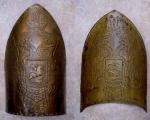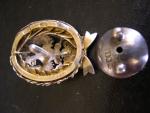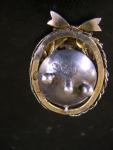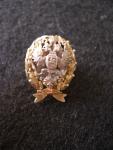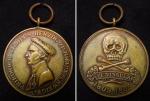-
Posts
235 -
Joined
-
Last visited
Content Type
Profiles
Forums
Blogs
Gallery
Events
Store
Everything posted by Ramblinfarms
-
Yeah but you have some mind-boggling documents! Thanks much for the comments guys. Tonight I'm going to watch "The Duellists" again. Haven't seen it for a long, long time, but my 11 year old has never seen it. It's a great movie! "I'm to fight a duel, on horseback, as a tribute to the Cavalry?!" Love it.
-
I have a few Napoleonic items, among them a 1796 Pattern English Hussar Saber, and a Tower British Sea Service Flintlock pistol, dated 1806. (A good year for the Brits!) On the French side, I have this nice pouch badge I thought I'd post for comments.
-
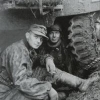
Imperial Russia Imperial Russian officer aglets
Ramblinfarms replied to Theodor's topic in Russia: Imperial
Hi Theodor. My guess would be a Grenadier Regiment. One of the other guys should be able to tell you more. Very beautiful. The quality sure seems to be there. Chris -

Imperial Russia IRAS SHOULDER BOARDS
Ramblinfarms replied to REGAL UNIFORMA COLECTOR's topic in Russia: Imperial
Interesting topic and beautiful boards and badges. These have got to be breathtakingly RARE! -
I agree. But each generation before and after has its heros, too. The more I read and hear about Vietnam, the more I am humbled by the dedication and sacrifices made by our men and women in uniform. Same for Desert Storm, Iraqi Freedom, and whereever our military is called on to perform. They are the true professionals.
-

Imperial Russia Some More Regimental Badges at Manions
Ramblinfarms posted a topic in Russia: Imperial
Here are a couple of new listings on Manions. There are some others that appear to be blatant fakes, but these two looked like they could have some possibility of authenticity. What do you think? http://www.manions.com/bid/bid.aspx?itemid...mp;pic=20060827 http://www.manions.com/bid/bid.aspx?itemid...mp;pic=20060827 -
Thanks Joe. I thought that people would like to read it. I'm very proud of my Dad and his service.
-
A good article in a local Queensbury, NY Newspaper back in 1999 in which my Dad's group was interviewed. Terrible Memories "Area veterans share emotional scars from brutal war experience" By Stacey Morris Staff Writer Published in The Post-Star newspaper 7/4/99 "...undoubtedly the greatest American battle of the war and will, I believe, be regarded as an ever-famous American victory." -- Sir Winston Churchill. GLENS FALLS -- The eight men gathered at the foot of Crandall Park's Victory & Peace Monument stood stiffly in a semi-circle, their feet shuffling side to side on the sun-sparkled granite. Their furrowed expressions had little to do with the unrelenting brightness of a cloudless June sky. They are all veterans of The Battle of The Bulge, one of the most ferocious battles fought during World War II, and they were being asked to remember. The somber overtones that ran through the semi-circle could be blamed on memories so traumatic most of them still get nightmares as a result. "To tell you the truth, I really don't like talking about it," said Ray Keech of Hudson Falls. "It was brutal." The eight area survivors range in age from 73 to 87. They'd agreed to share some of their recollections, but some memories they will never share. The brutality Keech speaks of took place over 50 years ago, when most of the men were just teen-agers. They were members of various Army divisions and were sent to push back the German troops who had overrun Europe. Their mission was to liberate as many countries as they possibly could from German oppression. To keep the Nazi troops at bay, Allied troops, including American and British soldiers, had formed a wall that ran north from Belgium to France. Hitler had formulated a last-ditch effort to try to break the wall. On Dec. 16, 1944, 30 German Divisions (nearly 250,000 men) burst across the 85-mile Allied front from southern Belgium to the middle of Luxembourg, causing a bulge in the line, hence the battle's name. John Wood of Argyle, who is now 73, was well acquainted with the downside of combat: the hunger that often accompanied days without a decent meal, the nonexistent sleeping accommodations, the sight of friends being maimed, constantly aching feet. But nothing prepared him for what lay ahead that day. Freezing, Dying "On the morning of Dec. 16, 1944," he recalled. "Hell came in like a freight train." The battle would last over a month and take 19,000 American lives. Queensbury resident Stanley Werner Jr., 73, who was 18 at the time, remembered losing his best friend to an incoming shell the first day of the battle. "I heard an explosion and went back to where my friend was," said Werner. "His legs were blown off ... he bled to death in my arms." The verbal recap of his friend's grisly death is glib. It is Werner's eyes that become agitated. They flicker from granite floor to monument to waving flag. To this day, memories of his friend haunt Werner. "He said he was going to be a doctor," Werner remembered, his voice trailing off. The memory of a French boy causes Argyle resident Les Bristol's hands to suddenly clasp together. "He couldn't have been more than eight," said Bristol, 87. "He was playing in a field and found a grenade." Curiously, the boy pulled the grenade's pin. Minutes later he was discovered in shreds by his hysterical mother. "She just kept screaming," said Bristol, his eyes suddenly moist. If the ferocity of the German troops weren't enough, the soldiers had to contend with snow, biting winds and sub-zero temperatures throughout the battle. Since the fighting took place mostly in the wilderness of the Ardennes mountain range that runs through eastern Belgium and Northern Luxembourg, men often had to carve makeshift shelters out of the frozen ground with pick axes. For many, the cold proved too much. Injured and unable to move, they froze to death in foxholes. Those lucky enough to escape injury had to contend with frozen feet and frostbite. "We wore our uniforms night and day," recalled Bristol. "If they got wet, the material would end up freezing." "My feet froze on Dec. 26," remembered Wood, who was subsequently hospitalized. "All we had were leather boots and cotton socks." No Reprieve The icy harshness of the Ardennes became its own insular world. All thoughts of the outside evaporated as the soldiers became immersed in a kill-or-be-killed atmosphere. South Glens Falls resident James Hoag remembered a surreal reprieve from the frozen battlefield on Christmas Day, 1944. "An elderly Belgian couple invited me into their house for cake," said the 80-year-old. "Til my dying day, I'll remember how Silent Night was playing on their radio in the kitchen." Hoag's face brightened for a moment when he remembered the small sliver of comfort inserted into the battle's panorama of horror. Hudson Falls resident Bill Chase was a soldier who never got even a moment of reprieve from the bloodshed. Chase, 75, of Hudson Falls, served as a combat engineer, which meant he lived on the front lines. He began his European service by landing on Omaha Beach in France. Slowly, he and his division fought their way across Europe. "We went by truck, by tank, on foot," he remembered. "However the hell we could." Chase ended up with three Purple Heart medals by the end of the war. After each injury, he was methodically returned to the front lines. "We just kept fightin'... killin' Germans," he said of his passage through Germany and then Czechoslovakia. There was an uncomfortable melancholy in his eyes as Chase recalled how, after being home for only three months after the war, he was driven from the bed he shared with his wife. "There were nightmares galore," he said. Seeking some emotional refuge from the war's lingering trauma, Chase went to confession at a nearby church. "Two priests chewed my ass when I told them what I did over there," he said gazing down at his thick hands. "Civilians don't understand." But fortunately, his fellow veterans do. Friendships Help In July of 1996, The Veterans of The Battle of the Bulge, Hudson Valley Chapter 49 was formed. The group meets four times a year and not, as Keech points out, to reminisce. "We go because of the friendships," he said. "It's good to have a shoulder to lean on." Keech just wrapped up a two-year term as treasurer of the organization and Argyle resident Coolidge Copeland was recently installed as president of the chapter, which covers the Hudson Valley Region through the Adirondacks. At their June meeting, Copeland pointed out Francis Miner, a Troy resident who went to Belgium a soldier and returned a seasoned mortician. A licensed funeral director, Miner's assistance was called upon following the Malmedy Massacre, an event deemed the worst atrocity against American troops in Europe during the war. On Dec. 17, 1944, Nazi soldiers lined up 86 American soldiers in a field in Malmedy, Belgium and executed them. Some, Miner said, were shot at close range. Others were bludgeoned with rifle butts. The few who had miraculously dodged the hail of bullets had the presence of mind to play dead, lying still for hours face down in the snow. Later, some of the few who survived were able to escape into the nearby woods but some were shot down while trying to run. Because of a heavy German presence surrounding the field, Miner and a crew of a dozen other soldier-morticians were not able to identify the bodies until Jan. 13, 1945 -- almost a month after the massacre. Over 80 bodies were frozen into about two feet of snow. Some were stiffened into grotesque configurations or were still in their stance of surrender Softspoken and tremulous, Miner began his recollection as gently as a bedtime story "The bodies were taken to a bombed-out rail station across the field," he said. "Their hands were so shriveled from being dead so long that we had to inject their fingers with fluid so they could be fingerprinted." As the bodies began to slowly thaw, Miner said the station's floor became a growing pool of blood and slush. The whole process took about a week. The victims of the Malmedy Massacre were buried in Belgium's Henri Chapple Cemetery until the end of World War II, when they were returned home. Chase remembered how word of the massacre inflamed the Allied troops. "After we heard about the Malmedy Massacre," said Chase. "We stopped taking prisoners." The others nodded silently, some smoothing back thinning hair, others standing with arms crossed, still looking at the granite. Jubilation As the battle wore on, Keech said the German troops began losing their resolve. "It broke Hitler's back when he made the last counterattack at The Bulge," he said. "That was his last stand." Eventually, the Germans were driven out of all the European countries they had occupied. Not every moment during the monthlong battle was filled with horror. There were triumphant days when the U.S. soldiers marched through towns they liberated. Surrounded by jubilant townspeople, the soldiers were showered with gifts of fruit as they moved through downtown districts that had been completely destroyed. Few Remember Under the bright June sun in Crandall Park, the eight men struggled to express their sentiments regarding what some soldiers termed "a frozen hell." Would they do it again? "I wouldn't want to do it again," said Keech. "But if I was called upon, I'd still pull the trigger." What bothers Keech more than anything is how little about the battle most people know. "People think The Battle of the Bulge is a weight-loss term," he said, shaking his head. "Education is the answer -- they've got to start teaching it in schools." Keech also hopes that a little knowledge about what was experienced will help generate some understanding -- or at least a little respect -- for the veterans, but especially for the country they defended. "I don't like seeing people talking or taking a sip of their beer as the flag goes by during a parade," he said. "Why can't they put their hand over their heart and honor their country?" The others are also disgusted by what they believe is a pervasive lack of patriotism today. "I say, if you don't like the country you live in, then go someplace else," Wood said. Werner added that those who regard parade-marching veterans, caps and all, merely as overly zealous old goats clinging to their glory days, are sorely missing the point. "Why do we feel so strongly?" he asked. "For our country's freedom, we were wounded, we saw friends die, we barely escaped with our lives." They all remain reluctant to accept verbal bouquets, tossed in the form of labels like "brave" and "hero." The praise is easier to accept in the guise of a prayer, like the one offered by the chaplain at the June meeting of the Veterans of The Battle of the Bulge: "... And let us thank these men, for because of them our country is safe today." All agree, it was a fight worth fighting. And if it fosters better understanding, it's a memory worth discussing. One of the eight observed that, he'd talked more about his war experiences during the brief gathering at the monument than he had to his family during the last 50 years. Did they go home heroes? "No," said Chase. "The heroes are the ones who didn't come home." THE BATTLE OF THE BULGE -- When -- Dec. 16, 1944 -- Jan. 25, 1945 -- Where -- The heavily forested Ardennes region of eastern Belgium and Northern Luxembourg. -- Who -- More than one million men: - 600,000 Americans: three U.S. armies and six corps (equivalent to 31 Divisions); -- 55,000 British: Three British divisions plus contingents of Belgian, Canadian, and French troops; -- Casualties -- German, 100,000; American, 81,000 including 19,000 killed; British, 1,400, including 200 killed. atrocity committed against American troops in Europe during the war -- The Veterans of the Battle of the Bulge National Office, Arlington, Va. Ray Keech and some of his fellow veterans visit area schools to educate students on The Battle of the Bulge and World War II. For more information, call Keech at 747-3831.
-

Imperial Russia Academy or Forestry Breast Badge?
Ramblinfarms replied to Ramblinfarms's topic in Russia: Imperial
These pics are from an ebay offering that is described as a "General Staff Academy Badge." In silver, hallmarked, with gilt wreath. -
Andolenko shows the General Staff/Nicholas Military Academy Badge as all silver, including the wreath. There is a thread here on the forum in which the identical badge, but with a gilt wreath, instead of silver, is ID'd as a Forestry Badge. Does anyone out there know for sure? Andolenko does not even list a "Forestry" Badge in either the civilian or Military Sections that I could see. This one is listed on ebay as a General Staff Academy Graduation Badge. Chris Werner
-
If I'm hearing you right, then 99% of what is available as far as REAL items come from shady provenance?! The exception to the rule being direct purchases from families in the former Soviet Union or expatriated? Or those objects several times removed from the original owner, but can be documented as being of that sort of provenance? From what I have been advised, it was not good for your health in Soviet Russia to retain the symbols of the monarchy, such as regimental badges and imperial marked Faerge. And I also understand there was a wholesale melting down of precious metal artwork and badges, jetons and such during WWII because of a shortage of gold and silver. As such, the survival of these items out of Government or institutional hands must be a very, very small percentage of what was actually manufactured. So where do most of the authentic badges, jetons, etc come from? Do we as collectors have a duty to inquire? Do we American and European collectors have a duty to assist in preserving what are really priceless relics of Russian history? I'd be interested in hearing your thoughts. Chris Werner
-
The inside job at Russia's Hermitage Alex Rodriguez From Chicago Tribune August 20, 2006 12:00 AM EDT Aug. 20--ST. PETERSBURG, Russia -- The annals of art heists brim with tales ready-made for a potboiler novel. In 2004, masked men brandishing .357 Magnums swiped Edvard Munch's "The Scream" as stunned museum patrons in Oslo looked on. The gang that pilfered nearly $1 million in paintings from a Paraguay museum four years ago dug an 80-foot tunnel to reach their quarry. But here in Russia's cultural capital, the story of the largest theft ever to strike the famed State Hermitage Museum appears to be the stuff of Franz Kafka, not Raymond Chandler. A sickly, cherub-faced museum curator sneaks out silver chalices and gem-festooned icons year after year in her tote bag, unnoticed by a security regimen that still relies on bound ledgers to track artifacts. When an audit in October 2005 finally reveals something is amiss, she keels over and dies at her desk. After authorities announce the thefts, buyers of the loot treat the items like briquettes of uranium, leaving them in train station lockers and trash bins. The dead curator, 52-year-old Larisa Zavadskaya, her husband, her son and another man are at the heart of an investigation into the theft of 221 art treasures valued at $5 million from Zavadskaya's storeroom during a span of up to eight years. St. Petersburg police remain tight-lipped about the case. But according to a version of events that the husband, Nikolai Zavadsky, gave his attorney, Larisa Zavadskaya only needed to stuff the pieces into her bag and walk out the door. "There was security at museum entrances, but when curators left the building they were never checked," said Zavadsky's attorney, Ludmilla Mikhailova. "It was quite easy to take these things." Zavadsky's version has not been confirmed by Russian authorities, who have arrested him along with the couple's 25-year-old son, a St. Petersburg antiques dealer, and another man who may have organized the plot. Museum authorities want to know what role was played by the son, who worked as a courier at the Hermitage. Zavadsky admits pawning some of the stolen items at St. Petersburg antiques shops, Mikhailova said. His wife also tried selling some of the artifacts to a St. Petersburg antiques dealer, police said. The scale of the thefts and the relative ease with which they were carried out have triggered a torrent of criticism about lax security at Russian museums. Only a week after the Hermitage case was made public July 31, Russian authorities announced that drawings worth $1.3 million by Soviet Constructivist architect Yakov Chernikhov were missing from Moscow's State Archive of Literature and Art. The crimes also reflect the culture of corruption that has seeped into every nook and cranny of post-Soviet Russian society, even the hallowed Hermitage. "The climate today is one of money and temptation," Mikhail Piotrovsky, director of the Hermitage, said in an interview. "People are now open to this kind of temptation, now that we live in a capitalistic society." Every year, as many as 100 artifacts are stolen from Russian museums, mostly the result of insider theft, said Boris Boyarskov, chief of Rosokhrankultura, the agency responsible for safeguarding cultural heritage. Early this month, Russian President Vladimir Putin ordered top security officials to carry out an inventory of the 50 million artifacts and works of art at Russian museums. Record-keeping poor Antiquated record-keeping adds to the vulnerability of collections at museums, Boyarskov said. While museums around the world log artifacts on computer databases, none of the 58 museums under the jurisdiction of Russia's Culture Ministry has completed the transition to computerized inventory. At the Hermitage, the move to computerized inventories began seven years ago, but only 153,000 of the museum's 2.8 million pieces have been logged, Boyarskov said. The rest are logged in handwriting in large, cumbersome ledgers. At the current rate, it would take the Hermitage 70 years to finish the transition to computers, Mikhail Shvydkoi, chief of Russia's federal cultural agency, said at a recent news conference. Just as problematic is the lack of supervision over Russian museum curators, a job that garners great respect and trust in Russian society even if it doesn't yield a big paycheck. At the Hermitage, curators were given wide latitude. Zavadskaya was one of only four people who had access to the room where the stolen items were stored. "When access is that tight, the curators rule. They can do whatever they want," Piotrovsky said. "We have always regarded the curator as a kind of holy person. Now we know that some of them are not so holy, so we'll have to control them." Authorities say thefts of items from Zavadskaya's storeroom began as long ago as 1997, after Zavadskaya became a curator at the Hermitage. Described by acquaintances as quiet and devoted to her work, Zavadskaya earned roughly $500 a month as a curator responsible for safeguarding 6,000 Hermitage pieces. She shared two rooms of a three-room communal apartment with her 54-year-old husband, who taught at a city university, their son, and her husband's parents, Mikhailova said. The lawyer says Zavadskaya's husband said the thefts were motivated by the family's money troubles, which partly derived from bills for drugs Zavadskaya needed to treat diabetes and heart troubles. Russian media have also quoted unnamed police sources as saying that a former academic colleague of Zavadsky's now under arrest, Ivan Sobolev, 38, helped organize the thefts. According to Mikhailova, Zavadsky took at least 50 of the pieces that his wife brought home and sold them at antiques shops in St. Petersburg, accepting $200 to $4,000 as payment. He never divulged their origin, telling shop owners that his wife had friends who wanted to sell the items. Zavadsky has confessed to his role in the thefts and is cooperating with investigators, Mikhailova said. Authorities say it is difficult to imagine that the items did not raise eyebrows at St. Petersburg pawnshops and antiques dealers: a silver chalice rimmed with amethysts, a Russian Orthodox icon with aquamarines and pearls, a brown agate vase atop a silver stem in the shape of a tree trunk. The pieces date from the late 1600s to the 20th Century. In October, as museum officials began a routine audit of the pieces under Zavadskaya's care, Zavadskaya came home from work in a panic, Mikhailova said. The next day at work, she collapsed at her desk and died of a heart attack. Afterward, museum officials spent months scouring other storerooms and offices for the missing items. On July 31 they announced the disappearance of the 221 pieces and posted a list on the Hermitage's Web site. A break in the case came Aug. 5, when a Moscow antiques dealer called police and said she had in her possession Item No. 60 on the list, a gilded silver chalice adorned with six-winged seraphs and enamel depictions of Christ, John the Baptist and the Virgin Mary. Russian newspapers reported that the information the dealer gave led to the Zavadskys and a St. Petersburg antiques dealer initially detained for questioning. That dealer was released from custody Tuesday. Dumping the evidence With the Hermitage case dominating headlines across Russia, some people in possession of stolen pieces appear eager to dump the items as quickly as possible. The most valuable piece, a $200,000 icon known as the Assembly of All Saints, was found Aug. 3 in a trash bin near a St. Petersburg police station. The next week a 19th Century silver ladle and a silver Russian Orthodox cross were recovered near the entrance of the St. Petersburg branch of the Federal Security Service, Russia's successor agency to the KGB. Other pieces have been recovered from lockers at a St. Petersburg train station. In all, at least 24 items have been recovered. Piotrovsky says there are facets to the case that still mystify him. Why steal 221 items when taking the most valuable pieces can fetch up to $200,000? Though Zavadskaya was a familiar face to Hermitage security guards, how could she get away with walking past them with a stashed chalice or icon for so many years? And perhaps the most vexing question on Piotrovsky's mind: How could someone entrusted with Russia's cultural treasures commit such a flagrant act of betrayal? "I can't understand," Piotrovsky said, "how a person who is a curator, a specialist in this kind of work, could do these kinds of things to a museum."
-
Gentlemen: The quality should not fool anyone, but still, for your reference, another site selling reproduction Imperial Russian items: http://members.aol.com/begemot/emporium/emporium.htm
-
The irony is rather clear!! Did you not tell me that many of these Russian folks are buying just to have "baubles" or "investment items", but have no clear love of the history behind them? There is an irony, too! I know a wealthy guy who collects vintage guitars, Martins, Gibsons, Fenders, etc. Yet he does not play! They are just objects to him, to hold on to for a while, and resell at a profit down the line. I have often wondered what those Russians who are interested in their history (I am sure that just like the USA, there are those who could care less), think of these items being stolen out of their museums, and resold to western collectors. It would be like finding out that Washington's flintlock pistols had been stolen out of the USMA Museum, and rumored to be resold to a wealthy middle eastern sheik-collector. Do you think that the Putin Investigation will impact the collecting market? E.g. markedly higher prices, a reluctance of collectors to sell and trade, increase in National sensitivity and refusal of families, people of Russian heritage, etc. to sell to collectors, and a flood of excellent fakes to fill the void? Here is an interesting site, for sale within Russia only, and get a load of the prices!!!!!!!! http://www.numismat.ru/cgi-bin/enindex.cgi
-
Police: Hermitage Curator Offered Art By VLADIMIR ISACHENKOV (Associated Press Writer) From Associated Press August 12, 2006 4:45 PM EDT MOSCOW - A senior Russian police officer said Saturday that a late curator, who has been the focus of an investigation into the theft of art from the State Hermitage Museum, had offered to sell some of the stolen items to an antiques dealer. Russia's most famous museum announced last month that 221 items worth $5 million, including jewelry, religious icons, silverware and richly enameled objects, had been stolen. The museum, on the banks of the Neva River in St. Petersburg, was the former Winter Palace of the czars. The thefts highlighted lax security and antiquated record-keeping at Russian institutions and underscored the funding crisis that has plagued museums and archives since the 1991 Soviet collapse. Larisa Zavadskaya, the curator in charge of the Russian art collection where the thefts occurred, died suddenly at work when a routine inventory check began last year. Earlier this week, police detained four suspects, including Zavadskaya's husband and their son, and charged them with involvement in the thefts. Zavadskaya's husband confessed that he and his wife were involved in some of the thefts and that they took place over several years, his lawyer said. Authorities so far have recovered 17 of the items stolen from the Hermitage, most recently a gilded silver cross dating from 1760 that a couple of St. Petersburg antique dealers returned to police Saturday. The dealers told investigators the curator repeatedly visited their shop to offer some of the items they later recognized from pictures of stolen objects released by the Hermitage, said Vladislav Kirillov, a senior police officer in charge of the investigation. One of the dealers, Alexander Ponomarev, said Zavadskaya did all the bargaining, claiming she was selling the objects belonging to her friends who had been in a car accident and needed money for treatment. "They brought many items, and that (the cross) was the only one we agreed upon," Ponomarev said in televised remarks. Kirillov said Zavadskaya's husband sold the cross a year ago, even as an inventory check began in the collection, and had kept the receipt. Police said he sold the item for 20,000 rubles, or $750 - less than one-tenth its real price. Russian media said Zavadskaya, an art scholar widely respected by her colleagues, lived in a ramshackle apartment that she and her family shared with other tenants in a dilapidated building in the historic center of St. Petersburg. Amid suggestions that low salaries for staff were partly to blame for the theft, Hermitage director Mikhail Piotrovsky said pay for museum curators could be increased. He also announced the museum would spend $5.5 million next year on security, including electronic monitoring of staff entering and leaving the collections. The head of Russia's federal culture agency, Mikhail Shvydkoi, formally reprimanded Piotrovsky, who has faced calls for his resignation over the lapses in security at the museum. On Thursday, President Vladimir Putin ordered top officials, including the head of the KGB's successor agency, to confirm the whereabouts of 50 million artworks at Russian museums following the Hermitage thefts. Only a quarter of the country's artworks have been inventoried since a check began six years ago, the first such survey since the waning years of the Soviet Union.
-
Here is the dark side of collecting Imperial and Soviet Russian. From the Hermitage?!!!! Unbelievable! Does anyone know the complete details? Chris MOSCOW, Aug 10, 2006 (UPI via COMTEX) -- Russian President Vladimir Putin has ordered an inventory of all cultural artifacts in the country's museums, it was announced Thursday. Deputy Prime Minister Dmitry Medvedev said Putin set a Sept. 1 deadline for the creation of a commission to conduct the inventory, RIA Novosti reported Thursday. He said the commission would be made up of officials from the Interior Ministry, the Ministry of Culture and Mass Communication, the Federal Security Service, the Prosecutor General's Office and other government bodies. The announcement follows an announcement in late July by Moscow's the Hermitage museum that an inventory revealed items missing from storage worth a total $4.85 million. Among the missing items are medieval and 19th Century jewelry, antique silverware and enameled objects. The museum said only staff members had access to the storerooms the items disappeared from. Three suspects have been arrested in the investigation, including the husband and son of a museum curator who died suddenly when the probe began.



